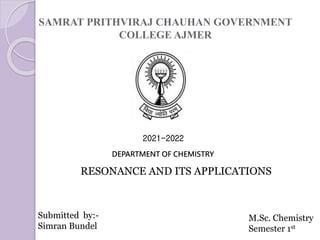
RESONANCE AND ITS APPLICATION
- 1. SAMRAT PRITHVIRAJ CHAUHAN GOVERNMENT COLLEGE AJMER 2021-2022 DEPARTMENT OF CHEMISTRY RESONANCE AND ITS APPLICATIONS Submitted by:- Simran Bundel M.Sc. Chemistry Semester 1st
- 2. TABLE OF CONTENT Introduction What is resonance ? Structure of Benzene Rules of Resonance Stabilities and contribution of resonating structure Resonance energy Resonance effect Applications of resonating effect References
- 3. INTRODUCTION Resonance and mesomerism are the two concepts that explains the delocalization electrons in a conjugated system, chemists use the terms interchangeably. The study of delocalization of electrons ,based on the quantum mechanical approach to the introduction of resonance. [HEISENBERG PAULING 1926]
- 4. WHAT IS RESONANCE ? • Resonance is a hypothetical state of a chmeical species in whuch its electronic structure can be represented hypothetically by two or more resonating structures . This representation of real structures as a weighted average of two or more canonical forms is termed as resonance. • Two or more structures of the same molecules or ions with same geometry with the same number of paired electrons but differing in the pairing arrangement of these electrons are termed as Resonance structures. • The actual structure of all the different possible structures that can be drawn for a molecule or ion without changing the relative position of atoms is termed as Resonance hybrid. • The resonance hybrid of chemical species is the real structure and the most stable structure then any of the resonating structure. Example: Resonance in phenol
- 5. STRUCTURE OF BENZENE Kekule structures (Most stable) 39% contributor (F.A. Kekule) Dewar structures (less stable) 7.3% contributor (J. Dewar) Resonance hybrid 6 p-orbital Delocalized
- 6. RULES OF RESONANCE a). The position of atom in a chemical species must remain unchanged in all the resonating structure. Carbonate ion b). Only π bonds can be converted into lone pair of electrons and vice-versa.
- 7. c). All the atoms taking part in the resonance i.e. the atoms that are a part of delocalized system must lie in same plane or be nearly planar. The reason for planarity is maximum overlap of the p orbitals . d). Most stable resonating structure contributes the most and vice-versa. e). The number of unpaired electrons must be same in each canonical form. Thus, the structure below of 1, 3- butadiene is not a valid canonical form. f). All the resonating do not contributes equally in the resonance hybrid. g). The resonance energy of the actual molecule (hybrid) is lower than that of any form, therefore delocalization is stabilizing phenomenon.
- 8. STABILITIES OF RESONANCE STRUCTURES The more covalent bonds a structure has the more stable it is. Structures of a maximum octets are preferred. Major contributor Minor contributo r 1,3-butadiene Major contributor Minor contributor Diazomethane
- 9. Enolate ion Structure with a negative charge on the most electronegative atom and positive charge on least electronegative atom contributes the most. Major contributor Minor contributor Major contributor Minor contributor Vinyl amine Uncharged structures contributes the most if different number of covalent bonds is present in different resonating structures.
- 10. Major contributor Minor contributor Carboxyllic acid Structures with isolated unlike charges have less contribution than those in which they are close to each other. Major contributor Minor contributor Phenol Structures with separated opposite charge will be less stable.
- 11. RESONANCE ENERGY o Resonance energy is the difference between the actual energy of a molecule(i.e. Resonance hybrid) and the energy calculated for the most stable of the resonating structure i.e. having minimum energy among the resonating structures. Resonance energy of benzene
- 12. RESONANCE EFFECT 1.) (-R ) or (+M) effect :-when an electronegative group or atom donates its lone pair of electrons in a conjugated system then it is said to possess electron donating effect or (-R ) effect. oThe lowering and decreasing of electron densities in a conjugated system when results in resonance and mesomerism , some effects are produces which are termed as Resonance effect (R-effect) or Mesomeric effect (M-effect). oTypes of (R) or (M) effect:- Aniline
- 13. 2.) (+R ) effect :- when a more electronegative group or atom in a conjugated system , withdraws the π – electrons from the system , then it is said to possess electron withdrawing effect or (+R effect). Nitrobenzene
- 14. APPLICATIONS OF RESONANCE EFFECT 1. Low reactivity of vinyl and aryl halides towards nucleophili substitution. 2. High reactivity of allyl and benzyl halides. Due to the resonance the carbon chlorine bond acquires some double bond character, thus binding halogen to carbon atom cannot be easily displaced in a substitution reaction. Both allyl and benzyl halides undergo ionization to give resonance stabilized allyl and benzyl cations .
- 15. Resonance may increase or decrease the magnitude of this resultant dipole moment depending upon the nature of the polar bonds present in the molecule. a.) Lowering of dipole moment »Dipole moment of vinyl chloride is much lower than ethyl chloride b.) Increasing the dipole moment » Dipole moment of p-nitro aniline is higher than that of nitrobenzene 3. Effect of dipole moment
- 16. Ethylamine strong base Acetamide weaker base 5.) Difference in C-N bond length for o and p-nitro groups The large iodide atom forces o-nitro groups out of the plane of benzene ring and has no effect on p-nitro group which remains in the plane of the ring. Therefore ,resonance operates in benzene ring involving p- nitro 4.) Comparison of relative base strength
- 17. REFRENCES Organic reactions and their mechanism by P.S. Kalsi Advanced organic chemistry (pragati prakashan) March’s organic chemistry by jerry march Reaction mechanism in organic chemistry by S.P . Singh and S.M. Mukherjee Organic chemistry by Anup pathak and Anupa saha Organic chemistry by Manju mehta and Bhupinder mehta
- 18. THANK YOU.......